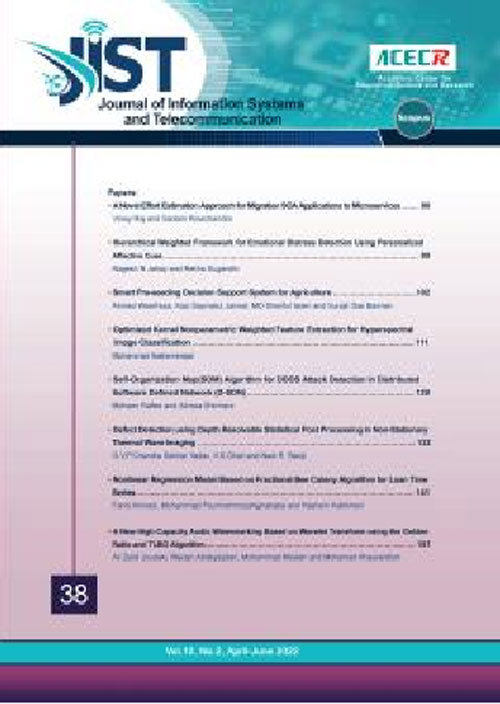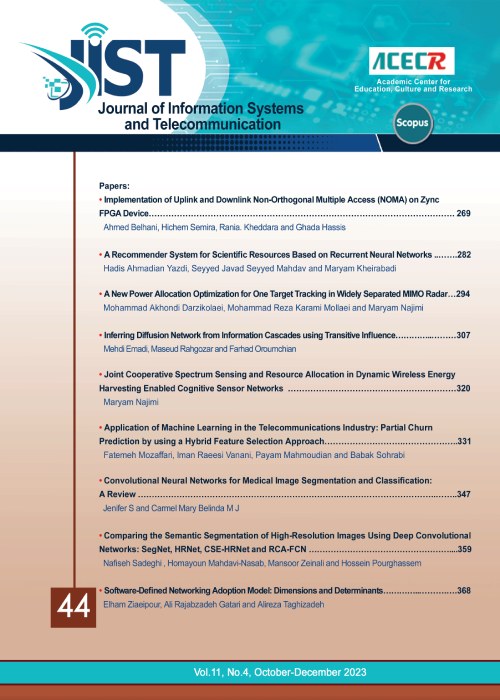فهرست مطالب

Journal of Information Systems and Telecommunication
Volume:10 Issue: 2, Apr-Jun 2022
- تاریخ انتشار: 1401/02/26
- تعداد عناوین: 8
-
-
Pages 80-88
Microservices architecture's popularity is rapidly growing as it eases the design of enterprise applications by allowing independent development and deployment of services. Due to this paradigm shift in software development, many existing Service Oriented Architecture (SOA) applications are being migrated to microservices. Estimating the effort required for migration is a key challenge as it helps the architects in better planning and execution of the migration process. Since the designing style and deployment environments are different for each service, existing effort estimation models in the literature are not ideal for microservice architecture. To estimate the effort required for migrating SOA application to microservices, we propose a new effort estimation model called Service Points. We define a formal model called service graph which represents the components of the service based architectures and their interactions among the services. Service graph provides the information required for the estimation process. We recast the use case points method and model it to become suitable for microservices architecture. We have updated the technical and environmental factors used for the effort estimation. The proposed approach is demonstrated by estimating the migration effort for a standard SOA based web application. The proposed model is compatible with the design principles of microservices and provides a systematic and formal way of estimating the effort. It helps software architects in better planning and execution of the migration process.
Keywords: Service Oriented Architecture, Microservices, Migration, Service Graph, Effort Estimation, Service point -
Pages 89-101
Emotional distress detection has become a hot topic of research in recent years due to concerns related to mental health and complex nature distress identification. One of the challenging tasks is to use non-invasive technology to understand and detect emotional distress in humans. Personalized affective cues provide a non-invasive approach considering visual, vocal, and verbal cues to recognize the affective state. In this paper, we are proposing a multimodal hierarchical weighted framework to recognize emotional distress. We are utilizing negative emotions to detect the unapparent behavior of the person. To capture facial cues, we have employed hybrid models consisting of a transfer learned residual network and CNN models. Extracted facial cue features are processed and fused at decision using a weighted approach. For audio cues, we employed two different models exploiting the LSTM and CNN capabilities fusing the results at the decision level. For textual cues, we used a BERT transformer to learn extracted features. We have proposed a novel decision level adaptive hierarchical weighted algorithm to fuse the results of the different modalities. The proposed algorithm has been used to detect the emotional distress of a person. Hence, we have proposed a novel algorithm for the detection of emotional distress based on visual, verbal, and vocal cues. Experiments on multiple datasets like FER2013, JAFFE, CK+, RAVDESS, TESS, ISEAR, Emotion Stimulus dataset, and Daily-Dialog dataset demonstrates the effectiveness and usability of the proposed architecture. Experiments on the enterface'05 dataset for distress detection has demonstrated significant results.
Keywords: Convolution Neural Network, Long Short-Term Memory, Transformers, Hierarchical Fusion, Distress Detection -
Pages 102-110
In recent years, the Internet of Things (IoT) brings a new dimension for establishing a precision network connectivity of sensors, especially in the agriculture and farming industry, medical, economic, and several sectors of modern society. Agriculture is an important area for the sustainability of mankind engulfing manufacturing, security, and resource management. Due to the exponential diminishing of the resources, innovative techniques to support the subsistence of agriculture and farming. IoT aims to extend the use of internet technology to a large number of distributed and connected devices by representing standard and interoperable communication protocols. This paper brings up a solution by IoT, presents the design and implementation of a smart pre-seeding decision support system for agricultural modernization. This project is accomplished by understanding the real-time circumstances in the agriculture field using wireless technology that highlighted the features including pH and temperature sensors, hardware, mobile application, system’s frontend, and backend analysis, and stores the extracted information in the cloud using IoT. The system is made up of frontend data acquisition, data transmission, data processing, and reception, and is also experimentally validated to find out all possible crops that can be cultivated in a specific land with the required amount of fertilizers as well as the overall crops distribution lists.
Keywords: Agriculture, Internet of Things, Pre-seeding, Decision support system -
Pages 111-119
Hyperspectral image (HSI) classification is an essential means of the analysis of remotely sensed images. Remote sensing of natural resources, astronomy, medicine, agriculture, food health, and many other applications are examples of possible applications of this technique. Since hyperspectral images contain redundant measurements, it is crucial to identify a subset of efficient features for modeling the classes. Kernel-based methods are widely used in this field. In this paper, we introduce a new kernel-based method that defines Hyperplane more optimally than previous methods. The presence of noise data in many kernel-based HSI classification methods causes changes in boundary samples and, as a result, incorrect class hyperplane training. We propose the optimized kernel non-parametric weighted feature extraction for hyperspectral image classification. KNWFE is a kernel-based feature extraction method, which has promising results in classifying remotely-sensed image data. However, it does not take the closeness or distance of the data to the target classes. Solving the problem, we propose optimized KNWFE, which results in better classification performance. Our extensive experiments show that the proposed method improves the accuracy of HSI classification and is superior to the state-of-the-art HIS classifiers.
Keywords: Feature Extraction, Image Classification, Optimized KNWFE, Hyperspectral, kernel -
Pages 120-131
The extend of the internet across the world has increased cyber-attacks and threats. One of the most significant threats includes denial-of-service (DoS) which causes the server or network not to be able to serve. This attack can be done by distributed nodes in the network as if the nodes collaborated. This attack is called distributed denial-of-service (DDoS). There is offered a novel architecture for the future networks to make them more agile, programmable and flexible. This architecture is called software defined network (SDN) that the main idea is data and control network flows separation. This architecture allows the network administrator to resist DDoS attacks in the centralized controller. The main issue is to detect DDoS flows in the controller. In this paper, the Self-Organizing Map (SOM) method and Learning Vector Quantization (LVQ) are used for DDoS attack detection in SDN with distributed architecture in the control layer. To evaluate the proposed model, we use a labelled data set to prove the proposed model that has improved the DDoS attack flow detection by 99.56%. This research can be used by the researchers working on SDN-based DDoS attack detection improvement.
Keywords: Software Defined Network (SDN), Distributed Controller, Distributed denial-of-service (DDoS), Self-Organizing Map (SOM), Learning Vector Quantization (LVQ) -
Pages 132-140
Defects that are generated during various phases of manufacturing or transporting limit the future applicability and serviceability of materials. In order to detect these defects a non-destructive testing modality is required. Depth resolvable subsurface anomaly detection in non-stationary thermal wave imaging is a vital outcome for a reliable prominent investigation of materials due to its fast, remote and non-destructive features. The present work solves the 3-Dimensional heat diffusion equation under the stipulated boundary conditions using green’s function based analytical approach for recently introduced quadratic frequency modulated thermal wave imaging (with FLIR SC 655A as infrared sensor with spectral range of 7.5-14µm and 25 fps) to explore the subsurface details with improved sensitivity and resolution. The temperature response obtained by solving the 3-Dimensional heat diffusion equation is used along with random projection-based statistical post-processing approach to resolve the subsurface details by imposing a band of low frequencies (0.01-0.1 Hz) over a carbon fiber reinforced polymer for experimentation and extracting orthonormal projection coefficients to improve the defect detection with enhanced depth resolution. Orthonormal projection coefficients are obtained by projecting the orthonormal features of the random vectors that are extracted by using Gram-Schmidt algorithm, on the mean removed dynamic thermal data. Further, defect detectability of random projection-based post-processing approach is validated by comparing the full width at half maxima (FWHM) and signal to noise ratio (SNR) of the processed results of the conventional approaches. Random projection provides detailed visualization of defects with 31% detectability even for deeper and small defects in contrast to conventional post processing modalities. Additionally, the subsurface anomalies are compared with their sizes based on full width at half maxima (FWHM) with a maximum error of 0.99% for random projection approach.
Keywords: Non-Stationary Thermal Wave Imaging (NSTWI), Fast Fourier Transform (FFT), Correlation, Random Projection Transform (RPT) -
Pages 141-150
High levels of nonperforming loans provide negative impacts on the growth rate of gross domestic product. Therefore, predicting the occurrence of nonperforming loans is a vital issue for the financial sector and governments. In this paper, an intelligent nonlinear model is proposed for describing the behavior of nonperforming loans. In order to find the optimal parameters of the model, a new fractional bee colony algorithm (BCA) based on fractional calculus techniques is proposed. The inputs of the nonlinear model are the loan type, approved amount, refund amount, and economic realm. The output of the regression model is that whether the current information is for a nonperforming loan or not. Consequently, the model is modified to detect the status of a loan. So, the modified model predicts the occurrence of a nonperforming loan and determines the loan status, i.e., current, overdue, and nonperforming. The proposed procedure is applied to data gathered from an economic institution in Iran. The findings of this study are helpful for the managers of banks, and financial sectors to forecast the future of the loans and, therefore, manage the budget for the upcoming loan requests.
Keywords: Artificial Bee Colony, Fractional Calculus, Nonlinear Economic Model, Loan Status Prediction -
Pages 151-160
Digital watermarking is one of the best solutions for copyright infringement, copying, data verification, and illegal distribution of digital media. Recently, the protection of digital audio signals has received much attention as one of the fascinating topics for researchers and scholars. In this paper, we presented a new high-capacity, clear, and robust audio signaling scheme based on the DWT conversion synergy and golden ratio advantages using the TLBO algorithm. We used the TLBO algorithm to determine the effective frame length and embedded range, and the golden ratio to determine the appropriate embedded locations for each frame. First, the main audio signal was broken down into several sub-bands using a DWT in a specific frequency range. Since the human auditory system is not sensitive to changes in high-frequency bands, to increase the clarity and capacity of these sub-bands to embed bits we used the watermark signal. Moreover, to increase the resistance to common attacks, we framed the high-frequency bandwidth and then used the average of the frames as a key value. Our main idea was to embed an 8-bit signal simultaneously in the host signal. Experimental results showed that the proposed method is free from significant noticeable distortion (SNR about 29.68dB) and increases the resistance to common signal processing attacks such as high pass filter, echo, resampling, MPEG (MP3), etc.
Keywords: Audio Watermarking, Discrete Wavelet Transform (DWT), High capacity, TLBO Optimization Algorithm


